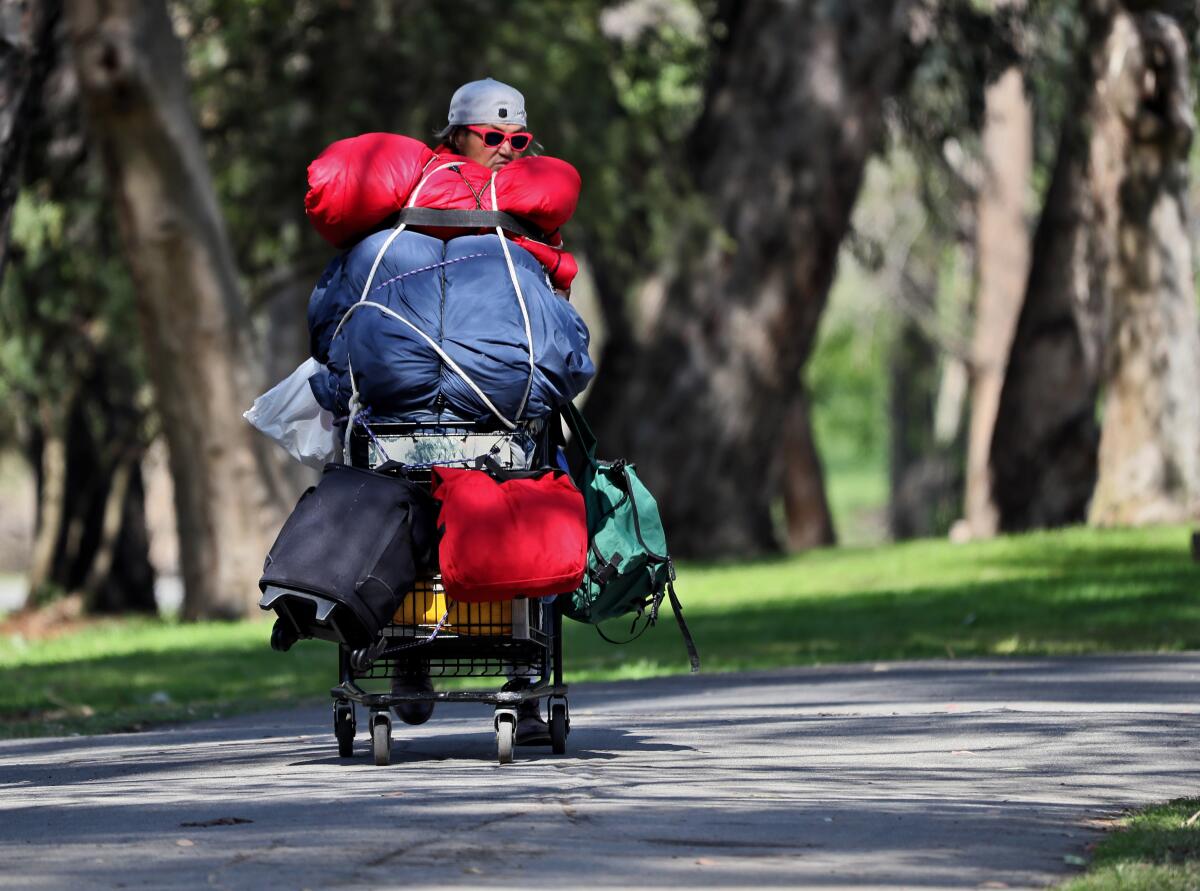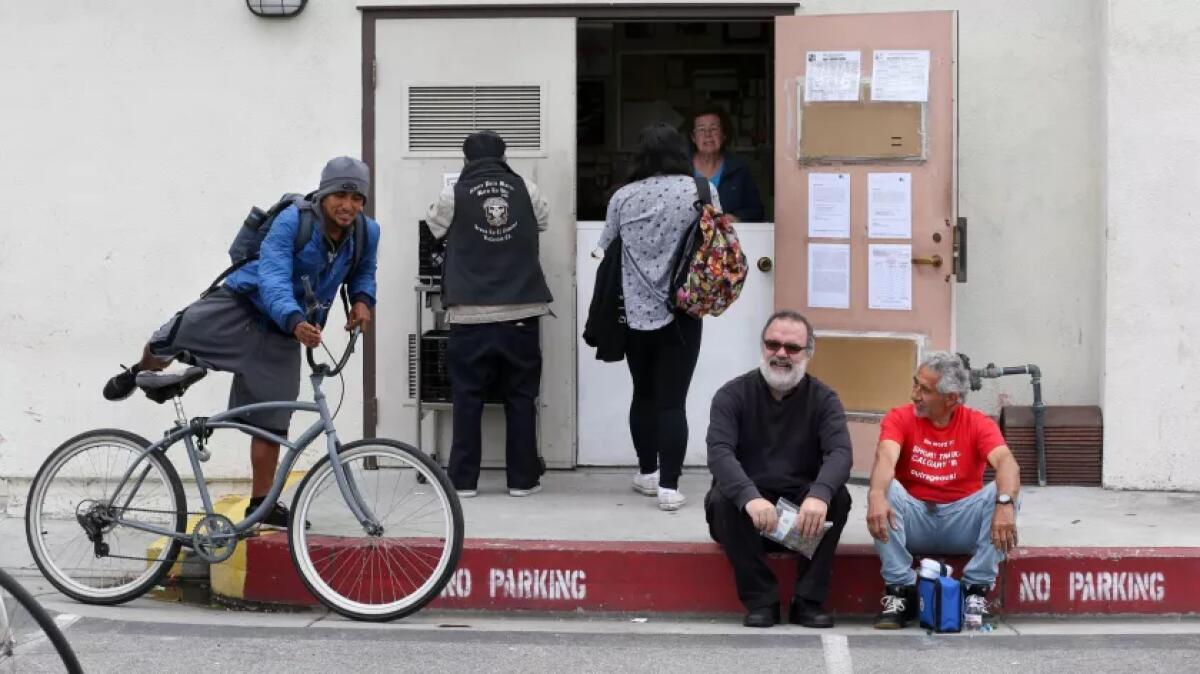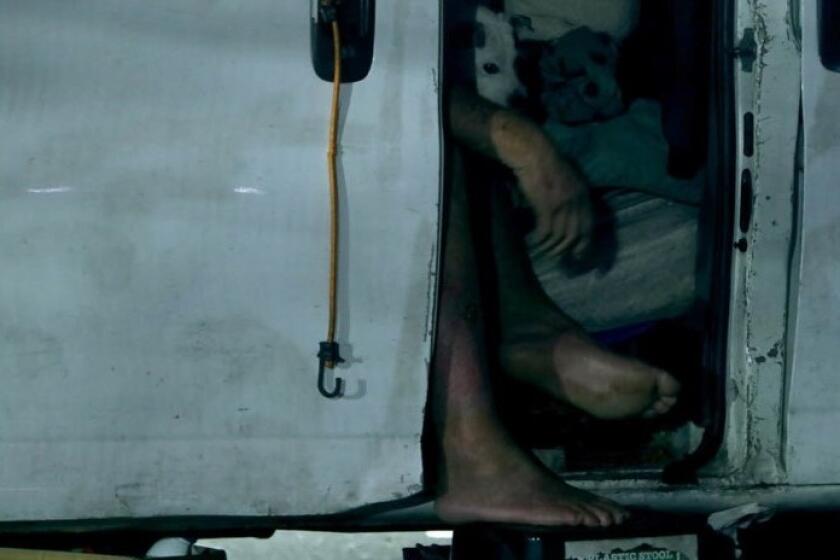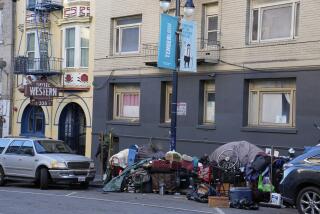Homeless advocates urge Orange County to create a safe parking program

- Share via
For about a year during the COVID-19 pandemic, dozens of homeless people living out of their vehicles parked on Valencia Drive in Fullerton.
The street served as a kind of imperfect haven, where people didn’t need to move their vehicles every few days to avoid parking citations or expose themselves to the dangers of parking in an unknown area. Then the city decided to start enforcing parking regulations that it had temporarily halted due to the pandemic.
Since then, homeless people have been cleared from the street and have scattered throughout the county, said Father Dennis Kriz of St. Philip Benizi Church.
Kriz and other religious leaders had been working to connect homeless people who lived on Valencia Drive with supportive services and housing options. The group of homeless advocates are known as the Tri-Parish Homelessness Collaborative, which is made up of St. Philip Benizi, St. Mary’s and St. Juliana Falconieri Catholic churches in Fullerton.
The collaborative served as the major voice advocating for the homeless who lived on Valencia. The group had also been pushing the city to bring back its safe parking program, which provided a lot for homeless people to park their vehicles in.
For homeless people who live in their cars, finding a safe place to park is a major obstacle. With many cities having overnight parking prohibitions, homeless people are forced to park in unsafe areas.

Fullerton has continually said it would not bring back its safe parking program but would be supportive of a more widespread program. The collaborative has since focused its efforts on pressing officials for a countywide program. What happened on Valencia highlights the need, Kriz said.
“Every day that these folks are not at some designated parking lot, they are scattered throughout the county, parking in places that they probably shouldn’t be,” Kriz said. “The faster that the city or the county responds to this, the sooner they will have less RVs parked throughout the county.”
Christa Johnson, interim deputy city manager of Fullerton, said in an email that the “city is working with the faith-based community, county and state officials on safe parking programs” and is holding meetings every two weeks to continue the discussions.
Kriz says the collaborative will be presenting the city and county with potential sites for a program. David Gillanders, executive director of Pathways of Hope — which worked with Fullerton on its safe parking program — said finding a site is the major obstacle to a countywide safe parking program. He said that some entity needs to step forward with a lot that can be dedicated for the program. This could include a city, county, college or businessperson.
Nonprofit-driven safe parking programs exist in Los Angeles and San Diego.
Jason Austin, Orange County’s director of the Office of Care Coordination, said in an email that the county would consider a safe parking program only if there was support and interest from a city to operate the program.
“The county aims to work collaboratively with its 34 cities in operating and creating programs that effectively address homelessness incorporating evidenced-based practices,” Austin said. “To operate a safe parking program according to common practice, there has to be an expectation for participants to provide ... vehicle documentation, current registration, insurance coverage and valid driver’s license with a focus on linking participants to shelter, housing or supportive service programs. The supportive service programs can include physical and behavioral health, housing, employment — needed services to assist in the process of becoming housed.”
The county and activists appear to agree on the general goal of any potential safe parking program.
Austin said a safe parking program shouldn’t just offer a place to park for the night, but it should also provide an opportunity for governments and service providers to engage with homeless people so they can eventually be connected with housing and move out of their vehicles.
Gillanders and Kriz said a countywide safe parking program that connects people with permanent supportive housing is needed.
The ‘Park Walk-Along’ will rotate through Huntington Beach’s Pier Plaza, Edison Park, Central Park, Greer Park and Linear Park-Sunset Beach, from 8 a.m. to 4:20 p.m.
But Austin pointed out that many people who live out of their RVs tend not to consider themselves homeless. He said this complicates the discussion surrounding safe parking programs because they are not looking to be connected with housing.
Like Austin, Gillanders drew a distinction between safe parking programs and people who live out of their RVs, stating that many people who live in their RVs consider it a home and are just looking for a safe place to park rather than looking to be connected with housing.
The need for a safe parking program is becoming more urgent as the number of homeless people living out of vehicles has increased and Gillanders said that number will only grow.
“COVID is going to probably continue to create this slippery slope of people who fall through the cracks,” he said. “We need to be prepared for an even greater influx of people who need this kind of resource.”
People living out of their vehicles have to contend with a variety of parking regulations throughout Orange County, some of which require a vehicle to be moved after 72 hours and other oversized vehicle laws that make it challenging for people to find safe places to park.
Mark Hamlet, who lived on Valencia, said he is again being chased out of spots regularly by police. Hamlet has been living out of his RV for decades and said he is conscientious when deciding where to park, avoiding neighborhoods and businesses with heavy foot traffic.
“There weren’t any oversized vehicle ordinances back when I started doing this,” Hamlet said. “They’re harassment and they’re discriminatory.”
Gillanders said the RV and parking ordinances that many cities have effectively criminalized homeless people who live out of their vehicles.
“Cities just have to decide the cost-benefit of just criminalizing people that do live in their vehicles versus trying to create an opportunity for them to stay somewhere,” Gillanders said.
When asked what the county does to help homeless people who are living out of their vehicles, Austin said there is a broad range of services, including for those who live out of their vehicles.
“The county operates homeless street outreach contracts that engage people living on the streets and connects them to emergency shelter and/or housing programs,” Austin said. “The county also operates emergency shelters that individuals can access that provide safe beds to sleep, access to meals, showers and onsite supportive services.
“Our ultimate goal is to engage individuals experiencing homelessness and support their transition out of sleeping in situations that are unsuitable for human habitation and into a housing opportunity.”
Brazil writes for Times Community News.
More to Read
Sign up for Essential California
The most important California stories and recommendations in your inbox every morning.
You may occasionally receive promotional content from the Los Angeles Times.












